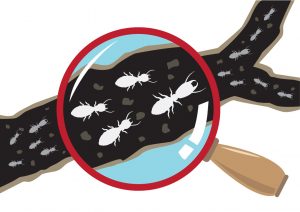Who Needs A Pest Inspection?
By Chris Williams on February 20, 2012.
Q. Who Needs A Pest Inspection?
A. Pest inspections are used to determine the presence of pest activity within a structure or area. There are many reasons for a pest inspection. Pest inspections are a crucial part of Real Estate transactions. Many lenders require an inspection for wood destroying organisms in order to process loans for the sale or re-financing of properties. Homeowners need to know if pests are damaging their homes. Commercial interests such as restaurants, grocery stores, rental properties, storage facilities, offices, and warehouses all have special needs with respect to pest activity. Pest inspections are a cost effective way to monitor for pest activity. Preventative measures as well as control measures can be taken as needed, dictated by the outcome of the inspection. Pest inspections are the first step in forming an integrated pest management strategy.
 Pest inspections for real estate transactions are centered on wood destroying organisms. Termites, carpenter ants, beetles, and fungi are the most common findings in real estate inspections. In the course of the inspection structural/mechanical deficiencies, leaks, and/or rodent activity may also be noted. The form NPMA-33 is the standard document used in the pest control industry for these inspections. The scope of the inspection is limited to the statements on the form. It may or may not be accompanied by a diagram of the structure (this is critical to list findings and obstructions).
Pest inspections for real estate transactions are centered on wood destroying organisms. Termites, carpenter ants, beetles, and fungi are the most common findings in real estate inspections. In the course of the inspection structural/mechanical deficiencies, leaks, and/or rodent activity may also be noted. The form NPMA-33 is the standard document used in the pest control industry for these inspections. The scope of the inspection is limited to the statements on the form. It may or may not be accompanied by a diagram of the structure (this is critical to list findings and obstructions).
The inspector will take note of the construction style, conducive conditions, and likely places for damage to occur. Stumps, timbers, bark mulch, drainage, soil grade, and other factors will be noted as to the likelihood of infestation. Although most of this information is not on the “form”, it can lead the inspector to areas frequented by pests. Areas with poor drainage, moss on siding, filled porches, standing water, wood to soil contact, etc… are all suspect. Siding that touches the ground, old lumber stored on the soil under decks, and garage door frames that penetrate the soil are all historic sites to locate live termites. Moisture problems are also important in considering where to look for wood destroying organisms. Ants, fungi, beetles, and termites need moisture to succeed. We look for leaks inside the structure: roof leaks, tub leaks, leaky faucets, stains, mold, puddles, standing water, clogged/broken drains.
The inspector checks inside for any sign of insects or fungi on wood members. The cellar is critical. Inaccessible places like voids, crawl spaces, and finished walls may hide damage or live activity. These areas should be noted on the diagram. Effort is made to visually inspect all accessible areas of the structure including the attic. Live insects, mud tubes, insect frass, insect bodies, structural damage, or other evidence may indicate the presence of wood destroying organisms. Evidence of prior pest treatment may be visible in the form of drill holes in the foundation, termite control stations in the soil, visible dust or spray residue, or on-going pest control efforts disclosed by the homeowner. If evidence of pest activity is noted, action must be taken to resolve the problem before closing takes place. About 45% of the homes I inspect have some type of recent or previous pest activity.
Pest inspections performed on a regular basis will ensure that developing problems are noticed before there is a serious issue. Construction deficiencies like holes in siding, plumbing leaks, damaged wires, and broken ductwork are frequent items noted in commercial accounts. Monitoring tools may also be deployed in an effort to locate the beginning of an infestation, or influx of invaders. By finding problems before there is an issue, preventative steps may be taken. This cost effective regime is an especially good way to maintain restaurants. With emphasis on sanitation practices and pest monitoring, a record is created and trends can be noted. Good sanitation equals less pest activity. Managers can use the information to motivate cleaning staff, and monitor their work from an “outside” standpoint. Regular pest inspection documentation is also helpful should health inspectors decide to visit. Monthly inspection reports provide the health inspector with proof that management cares, and a record of observed sanitation conditions and whether or not pest activity has been noted. As a rule, most establishments on this type of program are cleaner and have few if any pest issues.
General inspections are performed for clients that simply want to know what may be happening at their property. Residences, apartments, restaurants, offices, schools, storage facilities, etc… all may need to be inspected for pest activity at one time or another. A trained pest inspector will be able to provide detailed information about pest activity and make specific recommendations. If you need a pest inspection for Real Estate transactions, pest management, or some other reason, call a Pest Control Professional.